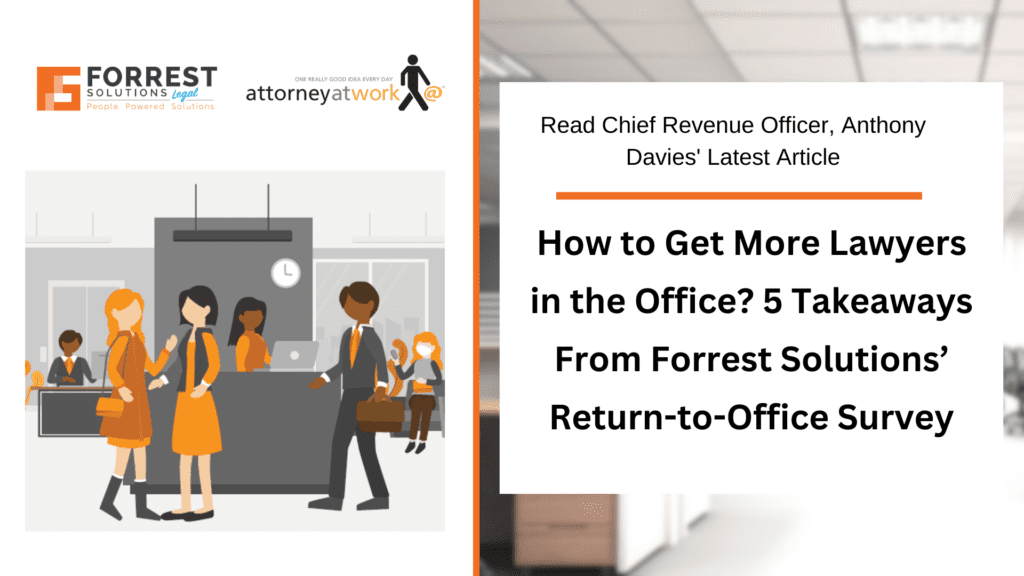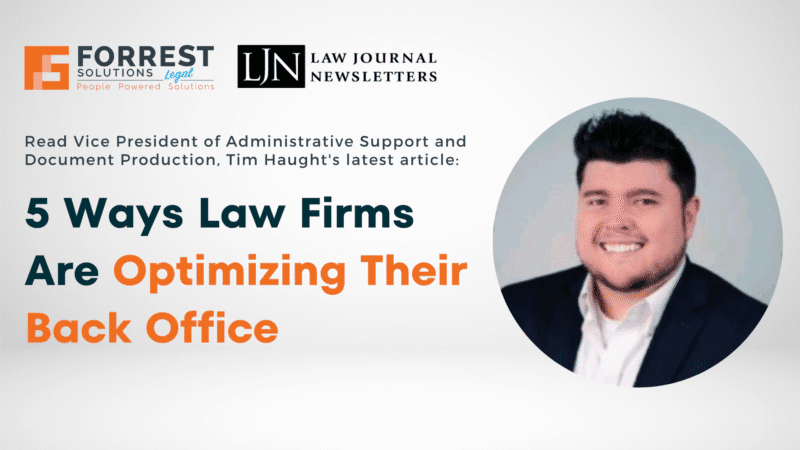
How to Get More Lawyers in the Office? 5 Takeaways From Forrest Solutions’ Return-to-Office Survey
By Anthony Davies
This article originally appeared in Attorney At Work Here: here
Hybrid operations may be here to stay, but what does success look like? For most law firm leaders, success means maximizing attorney time in the office.
We wanted to find out what firms are doing (or not doing) that is helping to do just that—maximize attorney time in the office– and so, in February of 2023, we launched the Forrest Solutions Return-to-Office Survey (the “Survey”).
Our Survey represents responses from approximately 20% of the top 200 law firms with a range of questions designed to gain insight on specific actions firms are taking and the specific outcomes.
Here are the top 5 takeaways from our results.
1: Nobody is complying
Unsurprisingly, the Survey data showed that the vast majority of firms (93%) have not returned to pre-Covid occupancy levels but are operating on a hybrid schedule. The majority of firms (66%) strongly suggest or recommend 2-3 days a week in the office. 20% of firms are mandating 2-3 days a week in the office. 7% of firms are mandating 4+ days in the office and 7% of firms have no policy at all.
Here’s the rather surprising news, however: of this group of ‘hybrid’ firms, 94% do not comply with their firm’s RTO policy.
2: Mandates have the highest non-compliance rate
Drilling into non-compliance, we were curious whether firms that have mandated a set in-office schedule were more successful than their strongly suggested counterparts.
However, it turned out that firms that mandated their RTO fared the worst and reported the highest rate of lack of compliance at 71%. Firms that strongly suggested their RTO policy fared much better, reporting over half (55.6%) of their attorneys do comply with the firm’s RTO policy.
And this is the real output of what ‘lack of compliance’ means: of the majority of firms that are strongly suggesting 2-3 days in the office, the result is 1-2 days a week in the office. The 20% of firms that are mandating 2-3 days a week in the office are achieving 2. The 7% of firms that are mandating 4+ days in the office are achieving 3, and the 7% of firms that have no policy are achieving less than 1 day a week, on average, in the office.
3: Firms that are trying new things are achieving more days in office
Firms that implemented at least one new program were able to attract their attorneys back iunto the office for more days on average than firms that tried no new programs at all.
Whether mandated or ‘strongly suggested’, new programs were found to move the needle: of the 12.5% that made no changes and tried no new programs, these firms averaged 2 days per week in the office.
However, of the 87.5% of firms that tried at least one new hospitality program, made at least one change or addition to their real estate including flexible workplace strategies, added at least one new amenity–these firms’ attorneys averaged 2.36 days in the office.
While this may at first appear to be an incremental difference, this is 18% or an extra 26 days a year, or 5 additional business weeks in the office.
And that’s significant.
4: The road to success is won incrementally
We saw incremental victories across each of the measured categories. Of firms that redesigned their floor space (29%), for instance, these firms averaged 2.42 days in the office. This is a 21% increase over the average 2 days a week of ‘non changing firms’ or an extra 30 days a year in the office, or 6 additional business weeks in the office.
Close behind this were firms that added amenities to their office which averaged 2.30 days in the office, 27 extra days a year or almost 5 business weeks, but even better were firms that enhanced hospitality which averaged 2.35 days in the office, or just over 5 additional business weeks per year.
More than half of firms started implementing some kind of hoteling and this actually increased days in the office to an average of 2.41 days to an extra 30 days per year or 6 business weeks.
5: Success is a combination of carrot and stick
Overall, we learned from the Survey that law firms have to earn their attorneys back into the office, and it’s a combination of carrot and stick.
When law firm leaders apply a variety of “carrots” to incentivize attorneys back into the office, incremental success is gained that, over time, can deliver significant impact to what leaders want: culture, collaboration and mentorship. An additional 6 weeks of in-person time in the office can be game-changing.
About Anthony Davies
Anthony Davies is Chief Revenue Officer of Forrest Solutions Legal. The 2023 Forrest Solutions Return-to-Office Survey can be accessed here.





